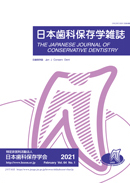Volume 64, Issue 5
Displaying 1-12 of 12 articles from this issue
- |<
- <
- 1
- >
- >|
Reviews
-
2021 Volume 64 Issue 5 Pages 303-307
Published: October 31, 2021
Released on J-STAGE: October 31, 2021
Download PDF (1069K) -
Utility of Light Emitting Diode for Treatment Strategies of Periodontal Disease and Peri-implantitis2021 Volume 64 Issue 5 Pages 308-313
Published: October 31, 2021
Released on J-STAGE: October 31, 2021
Download PDF (2216K)
Symposium in the Journal
-
2021 Volume 64 Issue 5 Pages 314
Published: October 31, 2021
Released on J-STAGE: October 31, 2021
Download PDF (104K) -
2021 Volume 64 Issue 5 Pages 315-319
Published: October 31, 2021
Released on J-STAGE: October 31, 2021
Download PDF (521K) -
2021 Volume 64 Issue 5 Pages 320-322
Published: October 31, 2021
Released on J-STAGE: October 31, 2021
Download PDF (269K) -
2021 Volume 64 Issue 5 Pages 323-326
Published: October 31, 2021
Released on J-STAGE: October 31, 2021
Download PDF (1611K) -
2021 Volume 64 Issue 5 Pages 327-331
Published: October 31, 2021
Released on J-STAGE: October 31, 2021
Download PDF (437K)
Original Articles
-
2021 Volume 64 Issue 5 Pages 332-338
Published: October 31, 2021
Released on J-STAGE: October 31, 2021
Download PDF (1257K) -
2021 Volume 64 Issue 5 Pages 339-347
Published: October 31, 2021
Released on J-STAGE: October 31, 2021
Download PDF (2602K)
Case Reports
-
2021 Volume 64 Issue 5 Pages 348-354
Published: October 31, 2021
Released on J-STAGE: October 31, 2021
Download PDF (783K) -
2021 Volume 64 Issue 5 Pages 355-363
Published: October 31, 2021
Released on J-STAGE: October 31, 2021
Download PDF (2616K) -
2021 Volume 64 Issue 5 Pages 364-370
Published: October 31, 2021
Released on J-STAGE: October 31, 2021
Download PDF (1829K)
- |<
- <
- 1
- >
- >|
